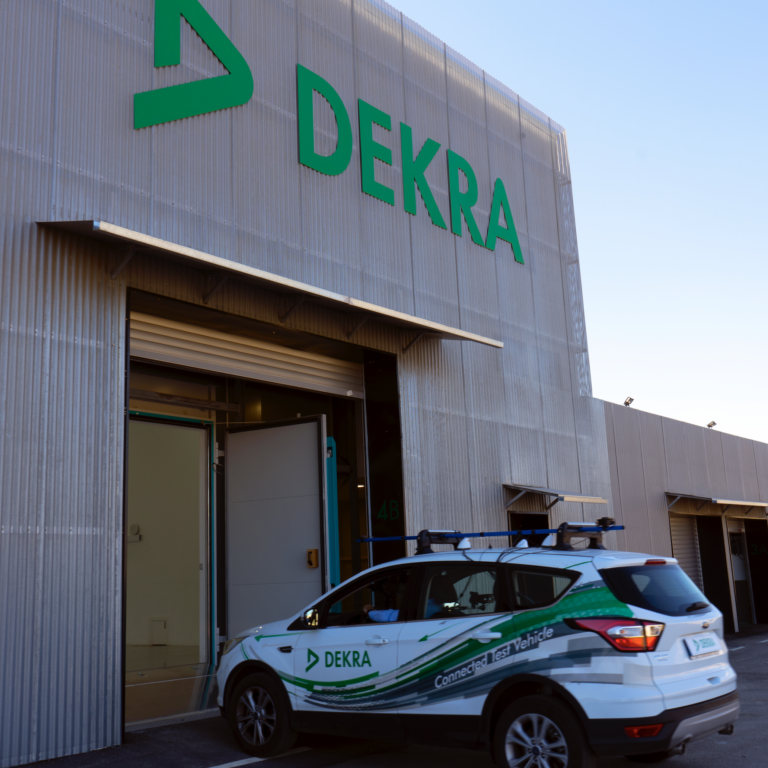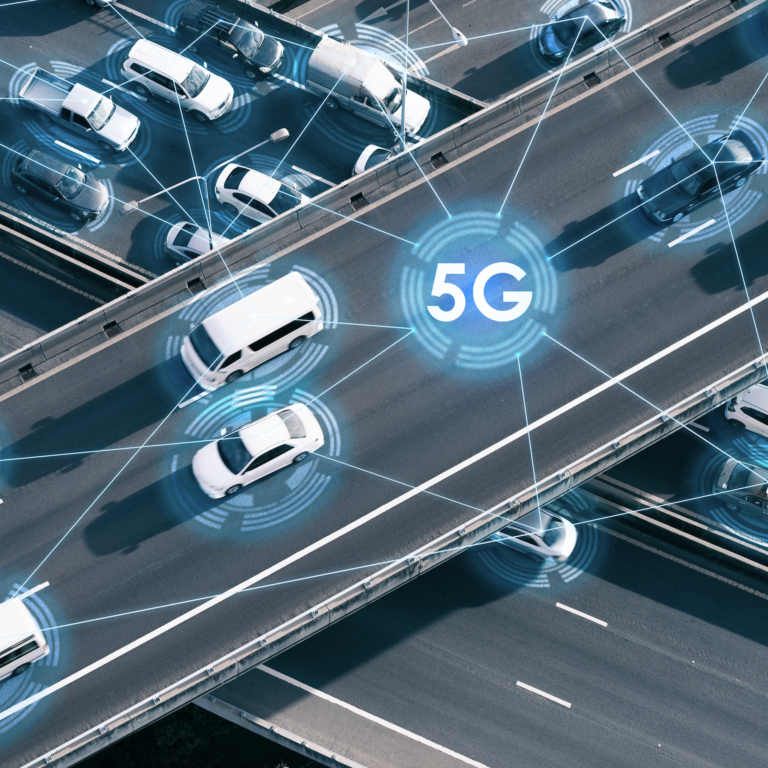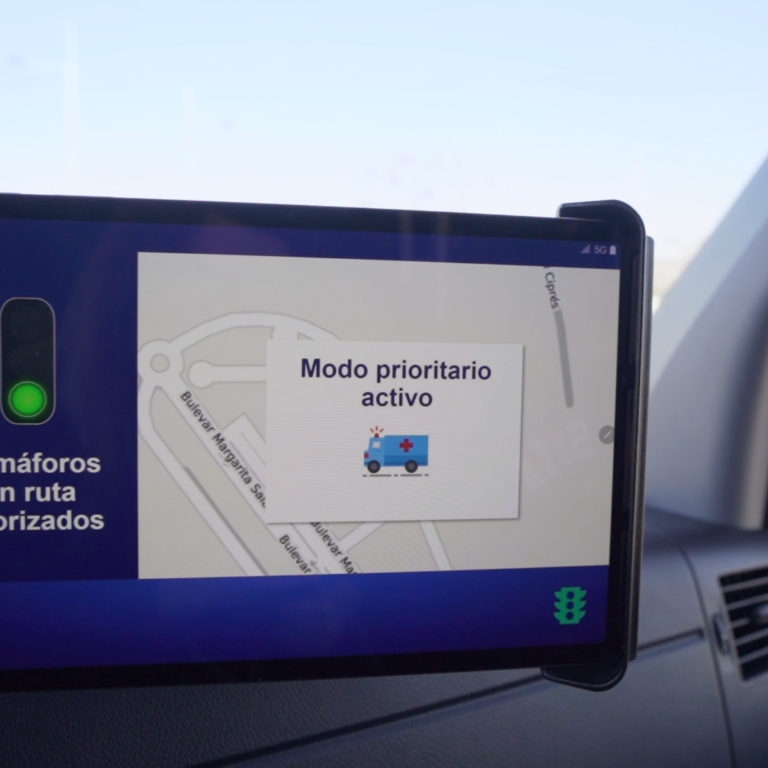5G Transformation Hub
How 5G can make roads safer
Millions of connected vehicles could use 5G to communicate securely in real-time
The world’s roads would be much safer if vehicles had a fast and secure way to communicate with each other and surrounding infrastructure. Enhanced with cryptographic-based security, 5G networks could make that happen.
Select a project
Contents
Challenge
To improve road safety, drivers would benefit from real- time information about what other vehicles in the vicinity are doing and any changes in road conditions. That information needs to be delivered quickly and securely through a trusted communications mechanism.
Solution
DEKRA and Telefónica are testing the use of a secure 5G connection to inform drivers when another vehicle suddenly brakes or has stopped on the road, or when traffic lights ahead are set to turn to red. In each case, the C-V2X communications are carried via Telefónica’s 5G network and are secured by the operator’s digital cyber-security certificates, underpinned by a public key infrastructure (PKI) integrated into the cyber-security node of the European Commission. The solution also makes use of mobile edge compute (MEC) to reduce latency.
Impact & Statistics
Telefónica says the solution can achieve a latency of milliseconds for millions of connected vehicles, thereby enabling drivers to receive the instant information they need to make decisions to avoid dangerous situations. That could ultimately reduce the number of injuries and lives lost in road accidents.
Wider Implications
The integration of a cryptographic-based security layer into 5G is designed to support more reliable and more secure connectivity. By ensuring identity and integrity in vehicular communications, the solution can guarantee trust between the different actors. This could facilitate the development of a secure mobility ecosystem with cross-border interoperability that is fully compliant with European standards.
Stakeholders
DEKRA, Nexus, HPE, Harman, CTAG, Telefónica Spain, Telefónica Tech
02
Millions of connected vehicles could use 5G to communicate securely in real-time
The world’s roads would be much safer if vehicles had a fast and secure way to communicate with each other and surrounding infrastructure. Enhanced with cryptographic-based security, 5G networks could make that happen.
At its facilities in Málaga, DEKRA is testing how 5G can help improve road safety. It is using Telefónica’s 5G network to provide real-time critical communications in three situations. Firstly, enabling a vehicle that suddenly brakes to automatically warn the vehicles behind to prevent accidents and smooth out the flow of traffic. Secondly, enabling a vehicle that has stopped on the road to alert other vehicles. Finally, vehicles driving on the circuit are notified of the colour (phase) of the traffic lights on their route in order to adapt their driving.
In each case, the C-V2X communications are secured using Telefónica’s digital cyber-security certificates. Telefónica uses cryptographic technologies to provide anonymous and interoperable cyber-security certificates that are valid throughout the European Union. The goal is to ensure the integrity of the vehicular communications, thereby creating trust between the different players in the connected mobility ecosystem.
The solution being piloted in Málaga also makes use of mobile edge compute (MEC) to reduce latency. Telefónica is aiming to achieve a latency of milliseconds for millions of connected vehicles, thereby enabling drivers to receive the instant information they need to make decisions and avoid dangerous situations.
However, the solution is still in the early stages of development. “This is a small proof of concept to prove the importance of cyber-security for mobility,” says Leticia López Domingo, expert in innovation and vehicular communications, Telefónica. “Currently, we are testing level 0 (proof of concept level) of the cyber-security solution, with a few devices on a closed environment (the DEKRA V2X circuit). In fact, the European Commission defines level 1 and level 2 as production levels and there is yet no player integrated on those levels.”
Still, the European Commission has recognised the PKI (public key infrastructure) platform developed by Telefónica for the provision of certificates to enable the electronic signing of messages in the European 5G-V2X ecosystem, thus guaranteeing the integrity and availability of the information. This PKI-V2X platform generates and sends batches of anonymous certificates to vehicles, traffic lights and other elements in the ecosystem via 5G. These certificates are then used to digitally sign the messages that are exchanged.
The European Commission has now integrated the platform into its cybersecurity node. “The key step is to deploy a Certification Authority recognised by the European Commission linked to the 5G network for vehicular communications and compliant with the requirements of the C-ITS (Cooperative Intelligent Transport Systems) standard,” explains Leticia López Domingo. “It is essential to ensure the integrity of the vehicular communications, creating a trusted V2X ecosystem.”
The pilot is also testing a solution to combine the identities of people with the identities of things, to support organisations that need to have control over possession, consumption and traceability in driving, such as vehicle rental and car sharing companies. Telefónica Tech is supplying its IDoT (Identity of Things) identification model, which uses the operator’s TrustOS platform to provide blockchain traceability for events relevant to the vehicle fleet, in strict compliance with the EU GDPR (General Data Protection Regulation).

03
5G can provide responsive and reliable connectivity
Intelligent transport systems depend on high-quality connectivity – the difffferent actors on the roads need to be able to immediately communicate with each other and exchange data. Telefónica says its 5G network, supported by edge computing, can provide massive connectivity, high bandwidth and ultra-low latencies simultaneously to the whole mobility ecosystem
The network is designed to deliver C-V2X data in real time securely and reliably. Secure connectivity is critical to ensure the data is accurate and can be trusted. Inter-vehicle communications need to be protected from any kind of spoofing or “man-in-the- middle” attack.
Telefónica worked with a number of partners to develop the solution being tested in Málaga. Harman, for example, deployed a network function to make the direct and secure vehicular communications more efficient, while CTAG integrated the connectivity module into the vehicles, while also developing the cooperative driving applications. HPE handled solution integration, while Nexus helped in the deployment of the public key infrastructure, ensuring the integrity of each message and the authorization of its sender can be guaranteed, while preserving privacy.
Telefónica says 5G networks are
a key part of its “next generation
communications infrastructure”
to enable new businesses, and
support economic development
and digital transformation of
many sectors. Telefónica is aiming to guarantee
the integrity, availability and
confidentiality of the information
carried over its 5G networks.
In the case of the V2X ecosystem,
Telefónica has positioned itself
as a trusted third party for the
signing of messages in the
European V2X ecosystem. That means end customers can use certificates generated by
Telefónica without the need to
undergo audits or prior registration.
For example, a general traffic department, other public entities, infrastructures and other users will be able to request certificates from the Certification Authority managed by Telefónica España, which will have specific permissions to sign messages with different characteristics. For example, a general traffic department could send a warning of traffic jam 2km ahead, a city hall could send a message saying only electric vehicles are allowed on a specific road, while infrastructure could communicate there is a red light at 150 metres, and a vehicle might flag it is emergency braking.


Leticia López Domingo
Expert in Innovation and Vehicular Communications, Telefónica
04
Protecting privacy by guaranteeing anonymity
Telefónica’s PKI platform has a root certificate that digitally identifies Telefónica’s Certification Authority, which is sent to the European Commission’s Central Point of Contact to be included in the list of trusted entities at a European level (ECTL – European Certificate Trusted List). In line with data protection and privacy regulations for individuals, the certificates provided to vehicles are anonymous to prevent the tracking of vehicle activity and therefore of individuals.
This approach ensures compliance with the GDPR. For the V2X-PKI platform, the next step will be to test interoperability with other V2X-PKI platforms from other trusted third parties. Currently, the V2X PKI platform is registered at level 0 (the proof of concept level) established by the European Commission. It now has to evolve to TLM level 1 (pre-production level) and finally TLM2 (production level). The Trust List Manager (TLM) is the entity that is in charge of managing the different companies integrated into the security solution. According to the standard, the TLM is responsible for approving or rejecting the insertion of a Root CA certificate in the Certificate Trust List (CTL) in accordance with the Policy Authority, as specified in ETSI TS 102 940.


Leticia López Domingo
Expert in Innovation and Vehicular Communications, Telefónica
05
Future plans network slicing may be a reality in 2024
Telefonica is preparing to rollout 5G SA (standalone) networks. These networks will have a 5G core that can support network slicing, enabling the 5G connectivity to be subdivided into multiple sub-networks that can be adapted to the demands of each customer in each use case. In the specific case of mobility, a specific sub-network will be dedicated to vehicular communications in order to guarantee such communications, separating them from other mobile traffic.
By 2024, Telefónica is hoping to create a specific 5G network for safety use cases with ultra-low latency requirements, and another sub-network for infotainment use cases where bandwidth is more important than low latency. “This capability together with the development of applications running on the edge will be essential elements for the democratization of connected vehicle and the future autonomous vehicle by being able to guarantee service at all times,” says Alejandro Alonso Portero, 5G innovation expert at Telefónica.
In the meantime, the telco is looking for Europe to follow in the footsteps of the U.S. by defining the V2X technology on which these communications will be established. The U.S. has opted for C-V2X technology. “We hope that Europe will soon decide to go for C-V2X as well. It is a preliminary and essential step to frame the scenario of future Smart Mobility,” adds Alejandro Alonso Portero.


Alejandro Alonso Portero
5G Innovation Expert, Telefónica
06
About
About the GSMA
The GSMA is a global organisation unifying the mobile ecosystem to discover, develop and deliver innovation foundational to positive business environments and societal change. Our vision is to unlock the full power of connectivity so that people,
industry, and society thrive. Representing mobile operators and organisations across the mobile ecosystem and adjacent industries, the GSMA delivers for its members across three broad pillars: Connectivity for Good, Industry Services and Solutions, and Outreach. This activity includes advancing policy, tackling today’s biggest societal challenges, underpinning the technology and interoperability that make mobile work, and providing the world’s largest platform to convene the mobile ecosystem at the MWC and M360 series of events.
For more information, please visit the GSMA corporate website at www.gsma.com.
Follow the GSMA on Twitter: @GSMA.
GSMA 5G Transformation Hub
The GSMA 5G Transformation Hub is a source of information on some of the most innovative 5G solutions in the world. This portal contains case studies detailing design, benefits, key players, measured value and the future impact of scaling up these 5G solutions worldwide. The 5G Era is now firmly established and this family of standardised GSM technologies, including mmWave, are being rolled out successfully across the globe. The GSMA 5G Transformation Hub, launched at MWC Barcelona in 2022, provides details of how 5G is best placed to deliver real value for a range of key sectors including manufacturing, energy, transportation, media and live entertainment, smart cities and construction.. Many more case studies will be added, in the coming months, covering even more industries and the GSMA is asking Members to nominate innovative 5G case studies to add to this global digital showcase. The 5G Transformation Hub and this particular Case Study are both sponsored by Qualcomm.
About this case study
This case study is for information only and is provided as is. The GSM Association makes no representations and gives no warranties or undertakings (express or implied) with respect to the study and does not accept any responsibility for , and hereby disclaims any liability for the accuracy or completeness or timeliness of the information contained in this document. Any use of the study is at the users own risk and the user assumes liability for any third party claims associated with such use.